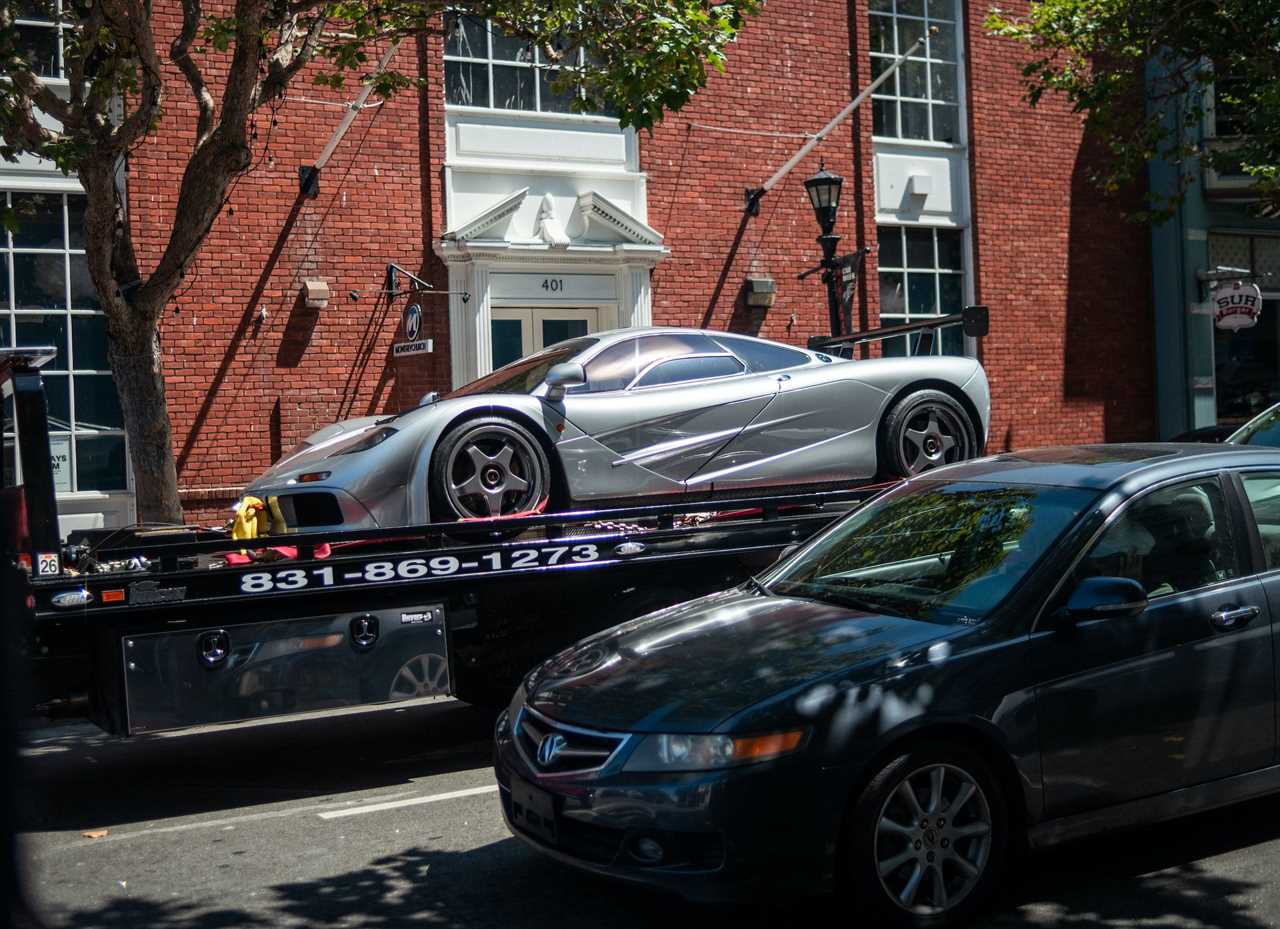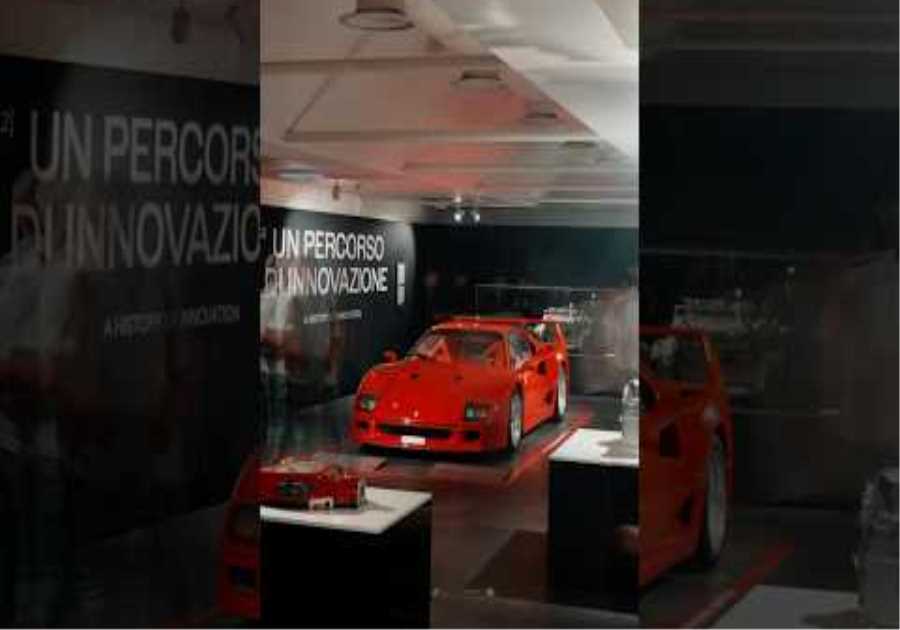
Of all the places to meet your hero, a dusty restoration shop in Seaside, California, is among the unlikeliest. It doesn’t get more anachronistic than the sight of a lightly disassembled McLaren F1 in a nondescript warehouse space, akin to stumbling upon a great Hollywood beauty going under the knife at a speakeasy; the back roads of Monterey Car Week are a long way from Woking, England. This 1998 F1 is number 059, which also happens to be the race number of the F1 that won Le Mans, and it’s going up for sale in a sealed-bid auction with RM Sotheby’s on Saturday, August 20.
RM Sotheby’s
With only 64 roadgoing examples and 106 cars in total, the F1 is, according to many, the supercar to end all supercars. A steady rise in value has supported that theory, with the last sale (chassis #029) trading hands at Gooding & Company for an auction-record-busting $20.5 million in 2021. That sale was a fresh-to-death, 243-mile Specimen still wearing its original Goodyear Eagle F1s and accompanied by a matching TAG Heuer watch—a Platonic ideal for OCD types, agony for those who actually enjoy driving.
The McLaren F1 authority known as Peloton25 (first name: Erik) suggests there was room for more, noting that “Gooding had pointed out these super-high-powered blue LEDs at the car for days, and a lot of people were given the impression that its nice brown paint was a sort of purple color.” He also says F1s tend to sell more in private transactions than at auction, citing when Lewis Hamilton purchased chassis #044 in 2017 for $15.6 million, while that same year Gordon Murray’s F1— admittedly, the one-of-a-kind XP3 prototype— achieved $25 million in a private sale. Also, he adds, George Harrison’s F1 traded hands privately last year for a reputedly heavenly sum. “I don’t get to see the wire transfer, but I’m told the price for that car exceeded $35 million. It’s an unrepeatable auction, sort of like a Steve McQueen premium that doesn’t make every other [F1] worth in excess of $35 million. But that’s where the market is going,” he adds.

Forest Casey
RM’s newly implemented sealed bid arrangement brings a bit of mystery to the equation, as the sale amount will be undisclosed when the auction closes on Saturday, August 20, at 4 pm PDT. This time around, the F1 in question (chassis #059) has a few more questions than #029’s straightforward history, given its sparse recent usage despite having 16,327 miles on the clock. The F1 has accumulated only around 100 miles over 10 years of ownership, some of which were required by the EPA certification process which took place when the vehicle was federalized in Texas in early 2013. Not exactly a reassuring figure for what some consider to be the best driver’s car of all time.

Forest Casey
Because one prospective bidder nudged for additional insights beyond McLaren Philadelphia’s “topical observations” documented on July 29, 2022, RM Sotheby’s decided to fly in a technician from noted F1 specialist Lanzante Limited for closer examination. For this particular investigation, Lanzante senior tech Jonathan Webb brought two checked bags full of gear (squeezed in with a minimal change of clothes) from the UK to evaluate #059.
The lanky Brit knows his way around F1s, having pored over numerous roadgoing and race-prepped examples over the years. While his personal tool kit covers most of the essentials (including some F1-specific bits like an adapter to plug in to the car’s now archaic OBD system, obviating the notorious Compaq LTE 5280 laptop), he had to borrow bulky items like the massive torque Wrench for the center-lock wheel nuts from Beverly Hills McLaren.

Forest Casey
Webb moves efficiently around the eight-figure Magnesium Silver F1, measuring tolerances with calipers, peering through crevices with a flashlight, and hunting down signs of wear, neglect, or irregularity while documenting every nook and cranny with cellphone snapshots. Virtually all needs noted in the 2012 report are still present, among them the 17 areas requiring attention, including suspension dampers in need of restoration, incorrect Pirelli tires (with lower-profile 335-mm rears, not 345s as intended), A/C not blowing cold, and miscellaneous mechanical concerns.

Forest Casey
Up on the lift, the F1’s underside presents as predictably flat, with a subtle seam between the carbon tub up front and the carbon-fiber tray at the rear that’s held in place by 13 steel bolts because titanium would be too soft for repeated torquing. Four small rectangular wooden skid blocks, the same as you’d find beneath Formula 1 and Le Mans racers, offset the otherwise modernist underbelly. A closer look reveals details like tiny circular indentations where the pedal boxes were fixed for the original owner based on personal spec.

Forest Casey
Noted in a 2012 UK report (when mileage was reported at 16,202) are unique build features including its one-off factory headlight assembly, which addressed the stock setup’s limited brightness by transplanting hardware from a BMW Z1, necessitating a longer, love-it- or hate it eyebrow panel above. This F1 is also one of nine cars fitted with the factory High Downforce kit, which adds a fixed rear spoiler, larger 18-inch wheels (as found in the LM and 1995/1996 GTR variants), brake cooling ducts at the spoiler pillar, and remote reservoirs added to the Bilstein shocks. Flaws noted in the writeup include a windshield crack (covered by an adhesive sunstrip), some glass delamination, and various chips and scratches.

Forest Casey

Forest Casey
Going over a McLaren F1 section-by-section reveals a seemingly endless cascade of Easter eggs that distracts from the very goal-oriented task of inspection. Among the more obvious bits is the rare sight of corroding gold foil, one of the most ironic metaphors embedded into a stratospherically expensive supercar. Webb points out that the gold insulating foil on the engine lid, across the firewall, on the catalytic converter cover, the diffuser ducts, the heat shields, the brake cooling ducts, and the bulkhead is flaking and will need replacing, noting a recommended replacement interval of 10 years or so. To the right of the center seat are aluminum latches labeled “E” and “L,” which open the engine and luggage bays—the latter of which releases a hinged door with a strut to ease the opening mechanism. Visible from below the car is an exhaust vent for the luggage compartment, which uses air drawn through venturi tunnels to create a vacuum for airflow. Also recessed within the space is an impossibly small anodized center-lock wrench; on the left side of the vehicle is another compartment that holds spare bulbs and fuses, as well as a first aid kit.

Forest Casey
Press the release button, and the dihedral door frees itself and slides upward easily, light as a feather. The revealed cockpit is a masterpiece of minimalism, incorporating cool-to-the-touch metal surfaces, carbon-fiber-plated surfaces, and that famous, centrally positioned driver’s seat that stares straight at a giant tachometer and through a remarkably deep, open-view windshield. F1 #059 features GT-spec seats, whose black and red Daytona-style design was an upgrade over the standard setup. Also nonstandard was the steering wheel, a removable Nardi unit that was commercially sold as the Tornado 200. Peloton25 believes it to be on one of only seven or eight. The wheel removes via a spring-loaded collar and incorporates small forefinger-actuated paddles, one for flash-to-pass, the other for the horn. The tiny paddles click with satisfying feedback and draw from an internal nine-volt battery to actuate an infrared transponder. As with so many elements of F1 ownership, the battery has a shelf life regardless of use, requiring replacement every two years.
Which brings us back to the wants and needs of this sparsely driven example. As noted by Kevin Hines of McLaren Philadelphia in his report, this F1 needs a fuel systems service, a pesky engine-out item that’s required every five years because the tank consists of a plastic sack, as in race cars. Webb says that “while in there,” it’s also time to service the engine, pull the gearbox out, and measure things like clutch plate thickness. Pulleys and belts ought to be replaced, as well as checking the tappets, checking for oil leaks, recharging the HVAC unit, and the like, not to mention replenishing that thermally protective gold foil. Incidentally, McLaren Special Operations now offers an aluminum tank replacement with zero service requirements, as does a supplier available through Dean Lanzante.
If all of this sounds like a lot, it is. But on a car potentially worth in the neighborhood of $20 million, the extensive service is also a drop in the proverbial bucket, as Peloton25 notes.
“In 2015, chassis #005 escaped from the clutches of the Brunei royal family,” he says. “It needed a full reconditioning, just like this car does, and it probably sat for even longer than this one. The bill from MSO was in the area of $120,000. That’s the price of a very nice BMW. But at the same time, it’s also less than 1 percent of the car’s value at this point.” fair enough
Speaking of value, one can’t talk McLaren F1s without transaction prices creeping into the conversation, a trend that has stained the simple joy of driving a supercar with abandon. The prime example is F1 designer and guru himself Gordon Murray, who once told Top Gear that he sold his F1 because “It became a little untenable to own.”
Here’s another tragic point to chew on: Peloton25 says, “If you look back at the 25thanniversary tour in 2017, there were 22 cars; this year for the 30th they had about a dozen.”

Forest Casey
After spending time with Webb during his inspection (and a few minutes sitting in the driver’s seat dreaming of V-12–powered greatness), we head back to the Monterey Convention Center where the F1 will be displayed, and sit down for a sidewalk lunch at a nearby restaurant. Though we’re surrounded by the typical Car Week assemblage of classic and exotic cars, one thing captures the rapt attention of the crowd: McLaren F1 #059, elevated on the flat bed of an open-air tow truck as it rolls down the boulevard . The buzz is instant and palpable, passing through the crowd like a wave as it swivels heads and triggers expletives. “There goes $20 million!” one onlooker blurts.
Or more. We may never know.
This content is imported from OpenWeb. You may be able to find the same content in another format, or you may be able to find more information, at their web site.
Did you miss our previous article...
https://formulaone.news/mclaren/seeing-albons-norris-success-in-rookie-season-difficult






